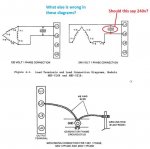MidKnightBomber
New member
- 42
- 0
- 0
- Location
- Salt Lake City, Utah
I have two questions that I hope will be pretty straight forward
Question #1-what errors are in the MEP701A/16B technical manuals that would affect my ability to properly hook up my Genset as back up power to my house?
Question #2-looking at the picture I have attached that comes straight out of the technical manual.....I am wondering how the two set ups are different on the load terminals? The left diagram is titled such that the output is supposed to be 120v, 1 phase. The right side diagram is titled such that it is supposed to output 240v, 1 phase. Yet BOTH images SHOW 120v between load terminals L1 and L2. How is this different between the two diagrams? I am suspecting an error in the TM. Can someone set me straight?
Thanks in advance,
I have read and read and read and am currently scheduling my electrician to come to my house to hook this stuff up and I feel this May be some of the final stuff I am "hopefully" lacking.

Question #1-what errors are in the MEP701A/16B technical manuals that would affect my ability to properly hook up my Genset as back up power to my house?
Question #2-looking at the picture I have attached that comes straight out of the technical manual.....I am wondering how the two set ups are different on the load terminals? The left diagram is titled such that the output is supposed to be 120v, 1 phase. The right side diagram is titled such that it is supposed to output 240v, 1 phase. Yet BOTH images SHOW 120v between load terminals L1 and L2. How is this different between the two diagrams? I am suspecting an error in the TM. Can someone set me straight?
Thanks in advance,
I have read and read and read and am currently scheduling my electrician to come to my house to hook this stuff up and I feel this May be some of the final stuff I am "hopefully" lacking.




